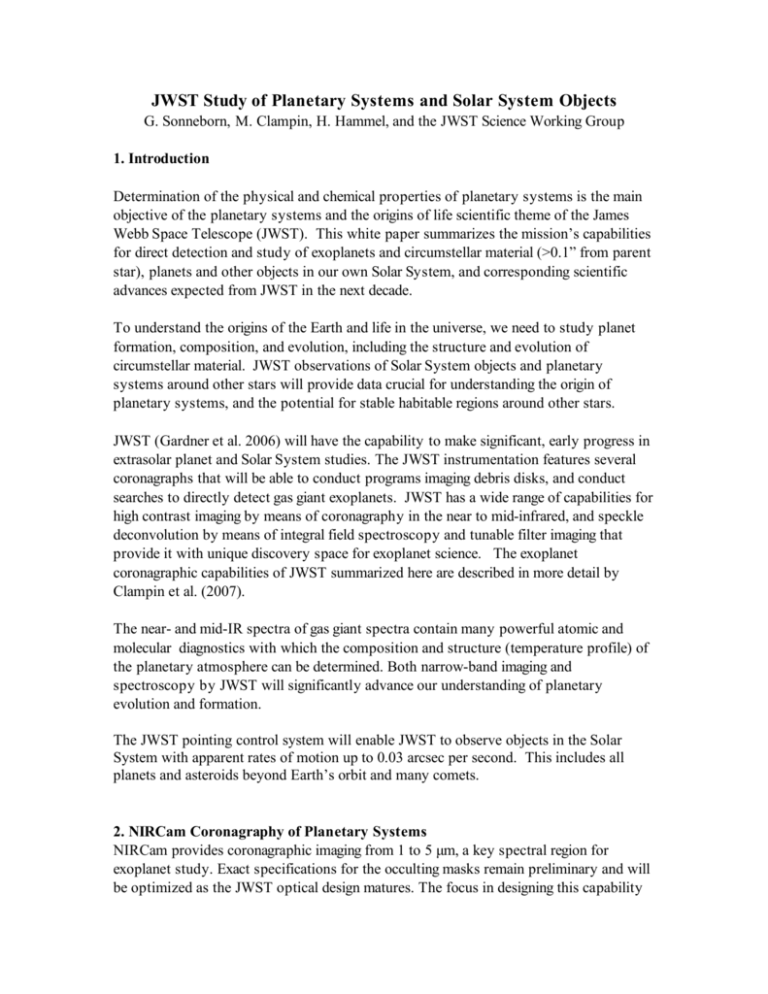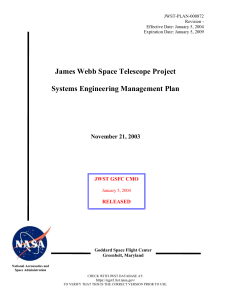JWST Study of Planetary Systems and Solar System Objects
advertisement

JWST Study of Planetary Systems and Solar System Objects G. Sonneborn, M. Clampin, H. Hammel, and the JWST Science Working Group 1. Introduction Determination of the physical and chemical properties of planetary systems is the main objective of the planetary systems and the origins of life scientific theme of the James Webb Space Telescope (JWST). This white paper summarizes the mission’s capabilities for direct detection and study of exoplanets and circumstellar material (>0.1” from parent star), planets and other objects in our own Solar System, and corresponding scientific advances expected from JWST in the next decade. To understand the origins of the Earth and life in the universe, we need to study planet formation, composition, and evolution, including the structure and evolution of circumstellar material. JWST observations of Solar System objects and planetary systems around other stars will provide data crucial for understanding the origin of planetary systems, and the potential for stable habitable regions around other stars. JWST (Gardner et al. 2006) will have the capability to make significant, early progress in extrasolar planet and Solar System studies. The JWST instrumentation features several coronagraphs that will be able to conduct programs imaging debris disks, and conduct searches to directly detect gas giant exoplanets. JWST has a wide range of capabilities for high contrast imaging by means of coronagraphy in the near to mid-infrared, and speckle deconvolution by means of integral field spectroscopy and tunable filter imaging that provide it with unique discovery space for exoplanet science. The exoplanet coronagraphic capabilities of JWST summarized here are described in more detail by Clampin et al. (2007). The near- and mid-IR spectra of gas giant spectra contain many powerful atomic and molecular diagnostics with which the composition and structure (temperature profile) of the planetary atmosphere can be determined. Both narrow-band imaging and spectroscopy by JWST will significantly advance our understanding of planetary evolution and formation. The JWST pointing control system will enable JWST to observe objects in the Solar System with apparent rates of motion up to 0.03 arcsec per second. This includes all planets and asteroids beyond Earth’s orbit and many comets. 2. NIRCam Coronagraphy of Planetary Systems NIRCam provides coronagraphic imaging from 1 to 5 µm, a key spectral region for exoplanet study. Exact specifications for the occulting masks remain preliminary and will be optimized as the JWST optical design matures. The focus in designing this capability has been exoplanet imaging at long wavelengths (4.5 µm). The five occulters are located on a transparent plate with clear areas of 20” x 20” each. Between the occulter fields are 5” x 5” neutral density squares to allow for the acquisition of bright stars. There are three radially-symmetric occulters with “sombrero” profiles (r=0.2”, 0.32”, 0.41”, corresponding to 6λ/D at 2.1, 3.35, and 4.3 µm) scaled to match the given wavelengths for disk and extragalactic imaging. Two wedge-shaped occulters with sinc2 profiles provide user-selectable widths, allowing for optimal imaging depending on wavelength. NIRCam will be capable of imaging young, Jovian planets via their thermal emission, which peaks near λ=4.5 µm. At this wavelength the planet/star contrast ratio can be better than 10-5. This spectral region is not easily accessible by ground-based telescopes due to the high IR background. For comparison, in visible scattered light Jupiter appears 10-9 as bright as the Sun, impossible for any current telescope to see around another star. 3. TFI Imaging and Coronagraphy of Planetary Systems TFI features a low-order Fabry-Perot etalon that covers the wavelength range 1.5-2.5 µm and 3.1-5.0 µm. The coronagraph is implemented through four hard-edged circular occulting spots (diameter : 0.58’’,0.75”, 1.5” and 2.0”) directly engraved on the pick-off mirror (POM). Each spot is spaced by 20” near the edge of the POM. The focal plane occulters are used in combination with apodization masks located in the pupil wheel. Contrast ratio of ~10-4 at 1 arcsec are expected at 4.6 µm. This performance should be improved by at least a factor 10 through proper PSF calibration (reference star or roll). TFI also features a non-redundant mask (NRM) optmized for point source detection with expected contrast of 10-4-10-5 between 0.1 and 0.5 arcsec. The NRM is optimized to operate between 3.8 and 5.0 µm. The wavelength scanning capability of TFI can be used to further suppress speckle noise using multi-wavelength imaging (MWI) speckle suppression algorithms (Marois et al 2000; Sparks & Ford 2002). This technique can improve contrast performance by at least a factor of 10. Atmosphere models predict that the spectral energy distribution of gas giant planets peaks beyond ~4-5 µm (M band), a spectral region strongly affected by very high background on ground-based telescopes. The spectral region beyond ~2.5 µm is thus a unique discovery space for JWST for exoplanet detection and characterization. By the time JWST is launched, next generation planet finder instruments on Gemini (Gemini Planet Imager; Macintosh et al 2006) and VLT (SPHERE; Dohlen et al 2006) should have found several tens of gas giant planets but few will have been studied in detail. The majority of these planets should be relatively massive (> 5 MJ), around relatively young (< 10-500 Myrs) AFGK primaries in local associations (<10-100 pc) and most of them should have separations between ~0.2” and 2”. All companions to AFGK stars at separations beyond ~1” should be detectable with TFI and NIRCam. The NRM mode of TFI will be capable of detecting young (1-2 Myrs) forming planets in Taurus. 4. NIRSpec Spectroscopy of Planetary Systems Planetary atmospheres will be characterized with near-IR spectra from NIRSpec. The 1-5 µm region contains many atomic and molecular transitions that are seen in absorption in planetary atmospheres, including species like H2O, CO2, O2 that are very difficult to detect in ground-based spectra due to high-IR backgrounds and terrestial atmospheric absorption by the same species. NIRSpec fixed slits will allow high-contrast spectroscopy of planets and disks as close as ~0.25” from the star. NIRSpec observations of nearby exoplanets can determine the nature of giant planet atmospheres, including abundances of ammonia and methane that are key indicators of atmosphereic mixing and temperature profiles. Detection of CH4, NH3, H2 O in the near-IR, as well as mid-IR with MIRI, samples different regions of the atmosphere, allowing abundance to be separated from temperature profile and the effect of clouds (Burrows et al. 2003). 5. MIRI Coronagraphy and Spectroscopy of Planetary Systems MIRI is JWST’s mid-infrared imager and spectrograph, and incorporates two coronagraphic imaging architectures. The coronagraphic focal plane mask assembly comprises three different quadrant phase masks (QPM), and a traditional coronagraphic occulting spot. Each of these focal plane masks images to a different pupil mask and filter combination. The three QPMs map to filters with central wavelengths of 10.65 µm, 11.4 µm and 15.5 µm (λ/δλ ~ 20), while the Lyot coronagraph pupil maps to 23 µm (λ/δλ ~ 5). The primary benefit of using the quadrant phase mask concept for MIRI is that it provides a good inner working angle and contrast. Note that a concern associated with the quadrant phase technique, its sensitivity to pointing, is not relevant for MIRI because JWST’s pointing accuracy far exceeds that needed for mid-IR imaging and is driven by JWST’s near-IR image quality requirements. In addition to its coronagraph complement, MIRI also features an integral field spectrometer (λ/δλ ~2500) and will be able to conduct speckle deconvolution imaging programs in a similar way to that discussed above for the TFI. MIRI will be able to detect gas giant planets with a broad range of characteristics. MIRI detection limits exceed that for a 30-m ground-based telescope by 1-2 orders of magnitude (see Clampin et al. 2007). Much of MIRI’s planet imaging capability will be complementary with the performance of NIRCam and the TFI. This is also the case for studies of planetary system formation. MIRI will be able to image debris disk systems in thermal emission with spatial resolution an order of magnitude better than Spitzer, complementing reflected light images from the nearIR. Mid-IR spectroscopy of gas giant planets will determine their atmosphere composition. 6. JWST Observations of the Outer Solar System The Kuiper Belt is a reservoir of icy bodies that orbit beyond Neptune, in the outer reaches of the solar system. Observations of the characteristics of the Kuiper Belt Objects (KBOs) have opened a window into the formation and early evolution of the solar system. Our knowledge of the Kuiper Belt exploded beginning in 1992, when a second KBO was discovered after a lag of decades since discovery of the first, Pluto. Astronomers have now identified more than a thousand bodies in the Kuiper Belt. JWST will have the sensitivity to obtain NIR R=100 spectra of all known KBOs (mv<25 mag), and higher resolution spectra of brighter ones. Similarly, JWST will be able to obtain mid-IR photometry (radii and albedos) of all known KBOs. These unprecedented capabilities will enable astronomers to use JWST to achieve the science goals described below. KBOs exhibit distinct dynamical classes, which can be generally sorted into four categories. Pluto is the archetype for "resonant" Kuiper Belt objects. It is locked into a 3:2 orbital resonance with Neptune, along with hundreds of other KBOs with similar resonant locking. These smaller objects are referred as Plutinos, in homage to the first known resonant KBO. Hundreds of KBOs carry the title "classical," referring to their location in a traditional "belt" with relatively low inclination. "Scattered" objects have increasingly high inclinations as a function of heliocentric distance. Yet another dynamical category is the "detached" KBOs. Here we discuss the broader implications of JWST observations of the physical and chemical properties of these differing classes of KBOs. Planetary scientists are actively debating two competing views of the origin and dynamical evolution of the Solar System. The older view -- based on data and modeling from the mid to latter part of the last century -- proposed that after accretion, the Solar System was relatively quiescent from a dynamical perspective. A newer paradigm developed in the late 1990s with the discoveries both of the diverse classes of Kuiper Belt Objects (suggestive of planetary migration), and of giant planets in exotic orbits around other stars. These discoveries, as well as improved theoretical modeling, have lead to detailed studies of giant planet migration and the dynamical disturbances from such migrations. The current leading hypothesis for our Solar System's formation posits that all four giant planets have undergone migration, with profound implications for the minor body populations. KBO's compositional make-up and chemical evolution provide clues of the earliest conditions in critical regions of the solar nebula, as well as having relevance to the current distributions of astrobiologically and cosmochemically important materials such as H2O and organic species. Currently, the only correlation between physical and dynamical properties is that the cold classical objects appear systematically redder than other objects (color discrimination is discussed further below). Otherwise, the full range of spectral types (red, neutral, featureless, volatile-bearing) seems to be equally well represented in the dynamical classes. Likewise, H2O ice has been detected on several KBOs based on absorptions at 1.5 and 2.0 µm, but others KBOs do not exhibit these bands. Because H2O contains very strong absorptions at wavelengths > 2.7 µm, JWST's near-infrared sensitivity will be well-suited to studies of water, as well as other ices such as CH4 and CH3OH. The greater sensitivity to ices will elucidate correlations between the presence of volatiles and any other dynamical or physical properties. As knowledge of the compositional types improves by observations like those to be done with JWST, it should be possible to identify source regions for the different compositional types. Then evolution can be “run in reverse,” and different evolutionary models examined. The goal is the eventual understanding of the evolutionary history of the Kuiper Belt, but observations of a much larger sample of objects are needed to flesh out and understand these groupings. JWST observations will reveal surface compositions and volatile inventories of all currently known KBOs. Such results will directly address the dynamical (and chemical) history of the Solar System, as well as the role that giant planet migration has played in Solar System evolution. Furthermore, radiometry of dozens of KBOs will enable better characterization of their albedos and hence the size distribution within the Kuiper Belt. Most KBOs have low visible albedos, but the nature of the dark material that lowers the albedos is unknown. The reddest Centaurs and KBOs require organics to explain the steep spectral slopes in the visible and near infrared. Surface compositions of the less red objects are even more uncertain. The neutral and moderately red spectra can be explained with either silicates or a variety of organics. Silicates and organics have very different spectral behavior at wavelengths > 3 µm, thus permitting the possibilities that spectra will determine their surface compositions. Such knowledge is crucial for understanding the distributions of organics, with direct implications for the chemistry and processes in the solar nebula. The species that have been put forth to explain the reddest KBOs have strong absorptions in the wavelength range of JWST's spectrometers, and have spectra that often differ widely from one another in that region. JWST will thus be pivotal for examining detailed surface chemistry within the Kuiper Belt. Pluto, Eris, Sedna, 2005 FY9, and 2003 EL61 are of particular interest because of their large size and hence potential for atmospheric and geologic activity. Pluto has abundant N2; some spectra also suggest the presence of N2 ice on Eris. Near-IR spectra reveal the presence of CH4 on all of these objects except 2003 EL61. Photolysis and cosmic-ray radiolysis are expected to quickly convert CH4 to higher-order carbon molecules, with resultant darkening of surface layers. However, Spitzer MIPS radiometry and HST imaging show that the albedos of these objects are quite high. This is probably the result of seasonal transport of the CH4, which will segregate the volatile ice from the photolytic products. The seasonally active layer should result in changes of the albedo patterns on the surfaces of these objects, and any others that may be discovered over the next few years. The geographic distribution of the volatile ices directly influences their temperature, and thereby the pressure of their vapor in the atmosphere. As the ices are transported across the surface by sublimation, both the appearance of the surface and the atmospheric pressure can be expected to undergo seasonal changes. Pluto's atmosphere has certainly changed dramatically over the past decade, as revealed by observations of stellar occultations seen through the thin veneer of atmosphere. Infrared data for Sedna should provide a unique test for constraining the composition in ways that cannot be achieved using current ground-based capabilities. Such data for Pluto, to which Eris and 2005 FY9 are best compared, revealed the expected CH4 absorption near 3.6 µm. However, Pluto's 4.5-µm reflectance has a rotational variation that is distinct from the other three bands, the visible albedo, or any of the near-infared spectral features. The variation manifests itself as two distinct spectral units on Pluto in the near infrared. This may be due to organic materials or previously undetected ices. Rotationally resolved lightcurves for other objects in this class could also reveal unique compositional and geographic information that cannot be obtained using any other existing capability. Neptune’s large moon Triton is the size of Eris, and is generally thought to be a captured KBO. Close up observations by Voyager 2 during its 1989 flyby revealed deposits of nitrogen ice that appear to shift seasonally from one hemisphere to another, sunlightdriven nitrogen geysers, and a crustal crater population that appears heavily modified by internal heating. Evidently these cold, large KBO’s are worlds unto themselves, with surficial and atmospheric activity. Detailed JWST observations will reveal seasonal behavior of the largest KBOs, and also significantly deepen our understanding of the compositions of their surfaces. The remnant of the circumstellar disk that formed our Solar System is observable today as comets, KBOs, along with zodical light, and interplanetary dust. Their current composition and physical properties provide a constraint on conditions in the solar nebula 4.6 Gyr ago. Comets and KBOs are a key factor for understanding how circumstellar disks around other stars form and evolve. Observations of comets with JWST will enable study of the chemical composition of cometary ice and dust with unprecedented sensitivity. Near- and mid-IR spectroscopy of cometary comae can measure abundances of H2O, CO2, CO, and CH3OH in even relatively faint comets. Near-IR spectroscopy (R~1000) can measure the ratio of ortho and para H2O, providing an indication of the comets formation temperature. Mid-IR spectroscopy can determine the mineralogy of cometary dust grains in virtually any comets passing through the inner Solar System. The results from cometary programs will be combined with studies of circumstellar disks to build a more complete picture of planetary system formation and evolution. The discovery of a population of icy cometary objects within the main asteroid belt (Hsieh & Jewett 2006) was the first new dynamical class of comets in over two centuries. These objects probably formed where they now reside, and potentially provide a new glimpse of the early inner Solar System and its evolution. They may be related to objects that were responsible for delivery of water to the Earth early in its history. These objects were discovered optically from their cometary tails, but are too faint (mv>20) for groundbased spectroscopy with current instrumentation. JWST will provide the first spectroscopic study of this new class of icy bodies. References Borrows, A., Sudarsky, D., & Lunine, J. 2003, ApJ, 596, 587 Clampin, M., et al. 2007, Coronagraphic Detection of Exosolar Planets with the James Webb Space Telescope (http://www.stsci.edu/jwst/science/whitepapers/) Dohlen, K., et al. 2006, SPIE, 6269, 24 Gardner, J. P. et al. 2006, Sp. Sci. Rev., 123, 485 Hsieh, H., & Jewett, D., 2006, Science, 312, 561 Macintosh, B., et al. 2006, SPIE, 6272, 18 Marois, C. et al. 2000, PASP, 112, 91 Sparks, W. B. & Ford, H. C., 2002, ApJ, 578, 543








